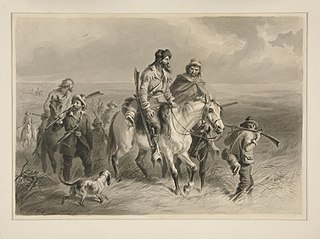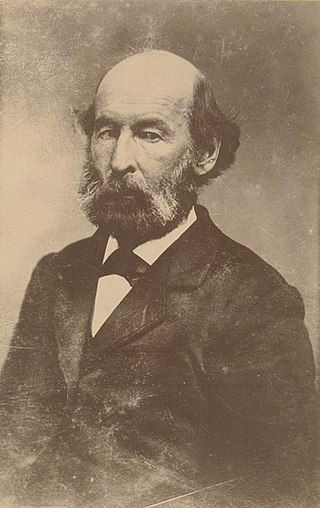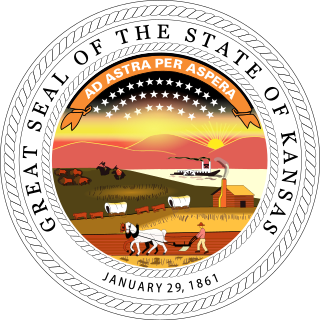
Lawrence is a city in and the county seat of Douglas County, Kansas, United States, and the sixth-largest city in the state. It is in the northeastern sector of the state, astride Interstate 70, between the Kansas and Wakarusa Rivers. As of the 2020 census, the population of the city was 94,934. Lawrence as well as Douglas County are part of the Kansas City–Overland Park–Kansas City, Missouri Combined Statistical Area. Lawrence is a college town and the home to both the University of Kansas and Haskell Indian Nations University.
The U.S. state of Kansas, located on the eastern edge of the Great Plains, was the home of nomadic Native American tribes who hunted the vast herds of bison. In around 1450 AD, the Wichita People founded the great city of Etzanoa. The city of Etzanoa was abandoned in around 1700 AD. The region was explored by Spanish conquistadores in the 16th century. It was later explored by French fur trappers who traded with the Native Americans. Most of Kansas became permanently part of the United States in the Louisiana Purchase of 1803. When the area was opened to settlement by the Kansas–Nebraska Act of 1854 it became a battlefield that helped cause the American Civil War. Settlers from North and South came in order to vote slavery down or up. The free state element prevailed.

Bleeding Kansas, Bloody Kansas, or the Border War was a series of violent civil confrontations in Kansas Territory, and to a lesser extent in western Missouri, between 1854 and 1859. It emerged from a political and ideological debate over the legality of slavery in the proposed state of Kansas.

The Territory of Kansas was an organized incorporated territory of the United States that existed from May 30, 1854, until January 29, 1861, when the eastern portion of the territory was admitted to the Union as the free state of Kansas.

Border ruffians were proslavery raiders who crossed into the Kansas Territory from Missouri during the mid-19th century to help ensure the territory entered the United States as a slave state. Their activities formed a major part of a series of violent civil confrontations known as "Bleeding Kansas", which peaked from 1854 to 1858. Crimes committed by border ruffians included electoral fraud, intimidation, assault, property damage and murder; many border ruffians took pride in their reputation as criminals. After the outbreak of the American Civil War in 1861, many border ruffians fought on the side of the Confederate States of America as irregular bushwhackers.

The sacking of Lawrence occurred on May 21, 1856, when pro-slavery settlers, led by Douglas County Sheriff Samuel J. Jones, attacked and ransacked Lawrence, Kansas, a town that had been founded by anti-slavery settlers from Massachusetts who were hoping to make Kansas a free state. The incident fueled the irregular conflict in Kansas Territory that later became known as Bleeding Kansas.
The Pottawatomie massacre occurred on the night of May 24–25, 1856, in the Kansas Territory, United States. In reaction to the sacking of Lawrence by pro-slavery forces on May 21, and the telegraphed news of the severe attack on Massachusetts Senator Charles Sumner, John Brown and a band of abolitionist settlers—some of them members of the Pottawatomie Rifles—responded violently. Just north of Pottawatomie Creek, in Franklin County, they abducted and killed five pro-slavery settlers in front of their families, which included several children. One teenage son of one of the settlers was also abducted by Brown and his fellow perpetrators, but was ultimately spared.

The New England Emigrant Aid Company was a transportation company founded in Boston, Massachusetts by activist Eli Thayer in the wake of the Kansas–Nebraska Act, which allowed the population of Kansas Territory to choose whether slavery would be legal. The company's ultimate purpose was to transport anti-slavery immigrants into the Kansas Territory. The company believed that if enough anti-slavery immigrants settled en masse in the newly-opened territory, they would be able to shift the balance of political power in the territory, which in turn would lead to Kansas becoming a free state when it eventually joined the United States.
The Wakarusa War was an armed standoff that took place in the Kansas Territory during November and December 1855. It is often cited by historians as the first instance of violence during the "Bleeding Kansas" conflict between anti-slavery and pro-slavery factions in the region.

Eli Thayer was a Republican member of the United States House of Representatives from 1857 to 1861. He was born in Mendon, Massachusetts. He graduated from Worcester Academy in 1840, from Brown University in 1845, and in 1848 founded Oread Institute, a school for young women in Worcester, Massachusetts. He is buried at Hope Cemetery, Worcester.

The Kansas Legislature is the state legislature of the U.S. state of Kansas. It is a bicameral assembly, composed of the lower Kansas House of Representatives, with 125 state representatives, and the upper Kansas Senate, with 40 state senators. Representatives are elected for two-year terms, senators for four-year terms.

"Beecher's Bibles" was the name given to the breech-loading Sharps rifle that were supplied to and used by the anti-slavery settlers and combatants in Kansas, during the Bleeding Kansas period (1854–1860). The breech loading model 1853 Sharps Carbines were shipped in crates marked "Books and Bibles". After an 1856 article in the New-York Tribune carried a quote by Henry Ward Beecher, the Sharps Carbines became known as Beecher's Bibles.
The Battle of Osawatomie was an armed engagement that occurred on August 30, 1856, when 250–400 pro-slavery Border ruffians, led by John W. Reid, attacked the town of Osawatomie, Kansas, which had been settled largely by anti-slavery Free-Staters. Reid was intent on destroying the Free-State settlement and then moving on to Topeka and Lawrence to do more of the same. Abolitionist John Brown first learned of the raiders when they shot his son Frederick. With just 40 or so men, Brown tried to defend the town against the pro-slavery partisans, but ultimately was forced to withdraw; five Free-Staters were killed in the battle, and the town of Osawatomie was subsequently looted and burned by Reid's men. The battle was one of a series of violent clashes between abolitionists and pro-slavery partisans in Kansas and Missouri during the Bleeding Kansas era.
The timeline of Kansas details past events that happened in what is present day Kansas. Located on the eastern edge of the Great Plains, the U.S. state of Kansas was the home of sedentary agrarian and hunter-gatherer Native American societies, many of whom hunted American bison. The region first appears in western history in the 16th century at the time of the Spanish conquest of the Aztec Empire, when Spanish conquistadors explored the unknown land now known as Kansas. It was later explored by French fur trappers who traded with the Native Americans. It became part of the United States in the Louisiana Purchase of 1803. In the 19th century, the first American explorers designated the area as the "Great American Desert."

Charles Lawrence Robinson was an American politician who served in the California State Assembly from 1851 to 1852, and later as the first Governor of Kansas from 1861 until 1863. He was also the first governor of a US state to be impeached by a state legislature, although he was found not guilty during subsequent State Senate impeachment trial and was not removed from office. After his time as governor he served in the Kansas Senate from 1873 to 1881. To date, he is the only governor of Kansas to be impeached.

The John Brown Museum, also known as the John Brown Museum State Historic Site and John Brown Cabin, is located in Osawatomie, Kansas. The site is operated by the Kansas Historical Society, and includes the log cabin of Reverend Samuel Adair and his wife, Florella, who was the half-sister of the abolitionist John Brown. Brown lived in the cabin during the twenty months he spent in Kansas and conducted many of his abolitionist activities from there. The museum's displays tell the story of John Brown, the Adairs and local abolitionists, and include the original cabin, Adair family furnishings and belongings, and Civil War artifacts.

Samuel Dexter Lecompte was an American jurist best known for his extreme pro-slavery views, his involvement in the events of Bleeding Kansas, and for being the founder and namesake of Lecompton, the erstwhile capital of the Kansas Territory.
The Battle of Fort Titus occurred during conflicts in the Kansas Territory between abolitionist and pro-slavery militias prior to the American Civil War. The era is known as Bleeding Kansas.
New Georgia's Fort was located in Miami County, Kansas, southeast of Osawatomie. During the partisan warfare in Kansas Territory in 1856 commonly known as Bleeding Kansas, a colony of Southerners, possibly all Georgians, established New Georgia. This colony was located on the Marias des Cygnes River. A blockhouse fort was constructed there and entrenchments were begun but the fort destroyed before the entrenchments could be completed. Northern settlers in the area claimed settlers at New Georgia harassed them. In reality, some settlers from both the North and South had groups who caused trouble with their neighbors.
Newell W. Spicer was a Union Army lieutenant colonel of volunteers during the American Civil War and a commander of the 1st Regiment Kansas Volunteer Infantry. He was also a leader of pro-abolitionist forces during Bleeding Kansas, a violent period in the history of Kansas when factions fought over proposals to abolish slavery in that state.












